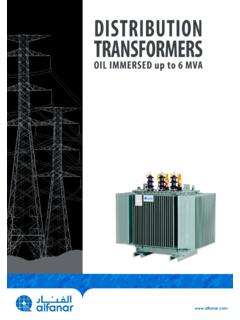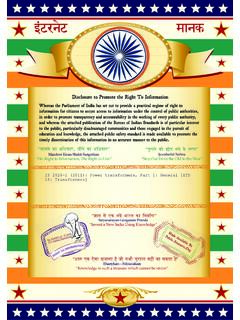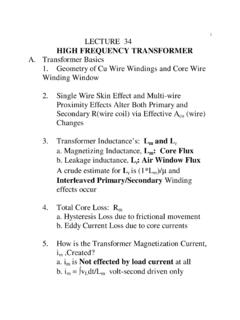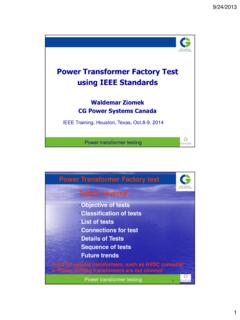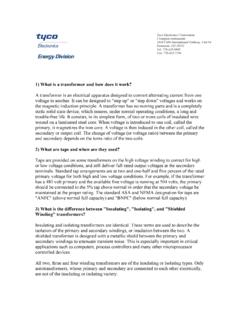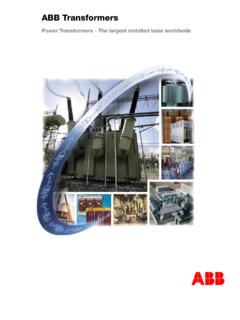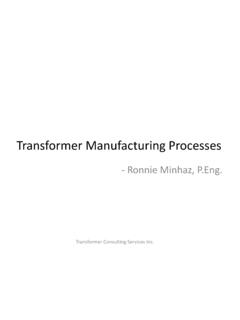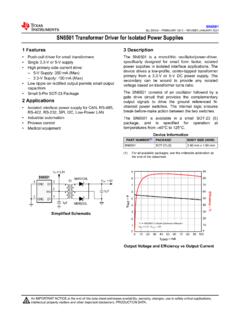Transcription of Section 4 – Power Transformer Design - Texas Instruments
1 4-1 Section 4 Power Transformer DesignPower Transformer DesignThis Section covers the Design of Power trans-formers used in buck-derived topologies: forwardconverter, bridge, half-bridge, and full-wave center-tap. Flyback transformers (actually coupled induc-tors) are covered in a later Section . For more spe-cialized applications, the principles discussed hereinwill generally of a TransformerThe purpose of a Power Transformer in Switch-Mode Power Supplies is to transfer Power efficientlyand instantaneously from an external electrical sourceto an external load. In doing so, the Transformer alsoprovides important additional capabilities: The primary to secondary turns ratio can be es-tablished to efficiently accommodate widely dif-ferent input/output voltage levels.
2 Multiple secondaries with different numbers ofturns can be used to achieve multiple outputs atdifferent voltage levels. Separate primary and secondary windings facili-tate high voltage input/output isolation, especiallyimportant for safety in off-line Storage in a TransformerIdeally, a Transformer stores no energy all energyis transferred instantaneously from input to output. Inpractice, all transformers do store some undesiredenergy: Leakage inductance represents energy stored inthe non-magnetic regions between windings,caused by imperfect flux coupling. In theequivalent electrical circuit, leakage inductance isin series with the windings, and the stored energyis proportional to load current squared.
3 Mutual inductance (magnetizing inductance) rep-resents energy stored in the finite permeability ofthe magnetic core and in small gaps where thecore halves come together. In the equivalent cir-cuit, mutual inductance appears in parallel withthe windings. The energy stored is a function ofthe volt-seconds per turn applied to the windingsand is independent of load Effects of Energy StorageLeakage inductance delays the transfer of currentbetween switches and rectifiers during switchingtransitions. These delays, proportional to load cur-rent, are the main cause of regulation and cross regu-lation problems. Reference (R4) included in thismanual explains this in inductance and leakage inductance energycauses voltage spikes during switching transitionsresulting in EMI and damage or destruction ofswitches and rectifiers.
4 Protective snubbers andclamps are required. The stored energy then ends upas loss in the snubbers or clamps. If the loss is exces-sive, non-dissipative snubber circuits (more complex)must be used in order to reclaim most of this and mutual inductance energy is some-times put to good use in zero voltage transition (ZVT)circuits. This requires caution leakage inductanceenergy disappears at light load, and mutual induc-tance energy is often unpredictable, depending onfactors like how well the core halves are mated and Temperature RiseTransformer loss is sometimes limited directly bythe need to achieve a required overall Power supplyefficiency.
5 More often, Transformer losses are limitedby a maximum hot spot temperature rise at the coresurface inside the center of the windings. tempera -ture rise ( C) equals thermal resistance ( C/Watt)times Power loss (Watts). TRPTL= Ultimately, the appropriate core size for the ap-plication is the smallest core that will handle the re-quired Power with losses that are acceptable in termsof Transformer temperature rise or Power supply Rise LimitIn consumer or industrial applications, a trans-former temperature rise of 40-50 C may be accept-able, resulting in a maximum internal temperature of100 C. However, it may be wiser to use the next sizelarger core to obtain reduced temperature rise andreduced losses for better Power supply are difficult to predict with loss data from core manufacturers is not alwaysdependable, partly because measurements are madeunder sinusoidal drive conditions.
6 Low frequencywinding losses are easy to calculate, but high fre-quency eddy current losses are difficult to determineaccurately, because of the high frequency harmoniccontent of the switched rectangular current wave-shape. Section 3 discusses this problem software can greatly ease the difficulty ofcalculating the winding losses, including high orderharmonics(1).Thermal ResistanceTemperature rise depends not only upon trans-former losses, but also upon the thermal resistance,RT ( C/Watt), from the external ambient to the centralhot spot. Thermal resistance is a key parameter, un-fortunately very difficult to define with a reasonabledegree of accuracy.
7 It has two main components: in-ternal thermal resistance RI between the heat sources(core and windings) and the Transformer surface, andthe external thermal resistance RE from the surface tothe external thermal resistance depends greatly uponthe physical construction. It is difficult to quantifybecause the heat sources are distributed throughoutthe Transformer . RI from surface to internal hot spot isnot relevant because very little heat is actually gener-ated at that point. Most of the heat generated in thecore (other than in toroids) is near the transformersurface. Heat generated within the winding is distrib-uted from the surface to the internal core.
8 Althoughcopper has very low thermal resistance, electrical in-sulation and voids raises the RT within the is a Design area where expertise and experienceis very helpful. Fortunately, internal thermal resis-tance is considerably smaller than external RE (exceptwith high velocity forced air cooling), and while RIshouldn t be ignored, it usually is not critically im-portant compared with RE is mainly a function of air convectionacross the surface of the Transformer either naturalconvection or forced air. RE with natural convectioncooling depends greatly upon how the Transformer ismounted and impediments to air flow in its Transformer mounted on a horizontal surface andsurrounded by tall components, or mounted in a rela-tively small enclosure will have considerably greaterRE than if it were mounted on a vertical surface,benefiting from the chimney effect.
9 With forced aircooling, RE can be driven down to a very small value,depending on air velocity, in which case internal RIbecomes the primary concern. With forced air cool-ing, thermal resistance and temperature rise often be-come irrelevant, because an absolute loss limit toachieve Power supply efficiency goals the average situation with natural convectioncooling, a crude rule of thumb can be used:RAES= 800 C - cm / Watt in cm C / Watt22 Where AS is the total surface area of the trans-former, excluding the mounting surface. CalculatingAS is time-consuming, but another rule of thumb sim-plifies this, as well.
10 For a given class of cores, such asE-E cores in the ETD or EC series, the relative pro-portions are quite similar for all core sizes. Thus forall cores in the ETD or EC series, the usable surfacearea, AS, is approximately 22 times the winding win-dow area, AW. Combining this with the equationabove enables the window area, AW, from the coredata sheet, to be used to directly calculate the exter-nal thermal resistance:RAEW= 36 in cm C / Watt2 For pot cores or PQ cores, window areas are pro-portionately smaller, and not as consistent. AS/AWmay range from 25 to 50, so that RE may range from16/AW to 32/AW is a great help in minimizing andcrudely quantifying thermal resistance.










